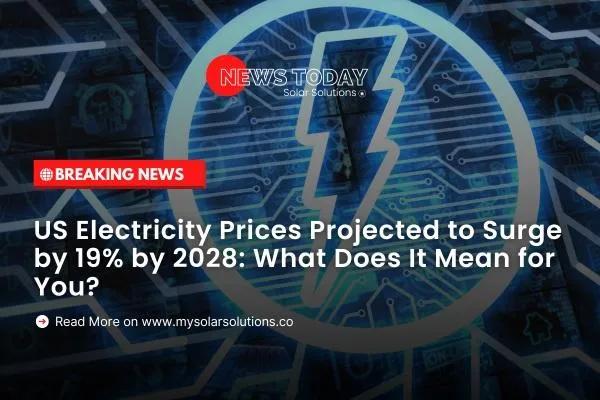The Solar Industries Trusted News Source
Solar News Today
Transparent Reporting for a Sustainable Future
Latest News Stories

US Electricity Prices Projected to Surge by 19% by 2028: What Does It Mean for You?
As we step into an era where the cost of living seems to be climbing every day, one looming question hangs over our heads: how will our electricity bills affect our wallets in the coming years? According to recent forecasts, we might see a hefty 19% increase in electricity prices across the U.S. by 2028. That's no small change, and it’s worth diving into the implications of this trend. Strap in as we break down the intricacies of this projection and what it means for consumers and the energy landscape.
Electricity Prices: A Closer Look
What Drives Electricity Prices Up?
Electricity prices aren't just plucked from thin air; they are influenced by a mix of factors. Here’s a rundown of what typically drives increases in electricity rates:
Supply and Demand: Just like any market, when demand spikes and supply dips, prices rise.
Fuel Costs: Changes in the price of natural gas, coal, and oil can significantly impact electricity prices.
Infrastructure Investments: Aging equipment and the need for upgrades often require additional funding, which can translate to higher bills.
Regulatory Changes: New regulations aimed at renewable energy integration can also influence costs.
Climate Factors: Weather extremes can lead to surges in electricity use, nudging prices upwards.
Current Trends in Electricity Costs
So, where do we stand today? Electricity prices have seen a consistent upward trend over recent years. The average cost per kilowatt-hour has fluctuated due to various economic and environmental factors. But the future predictions suggest that this upward momentum isn't slowing down—it's only accelerating.
The Forecast: 19% Increase by 2028
What This Means for the Average Consumer
Let's break down what a 19% increase by 2028 truly implies for average households. Assuming the current average cost of electricity is around $0.14 per kWh, a 19% hike would mean:
New Average Cost: About $0.166 per kWh.
Increased Monthly Bills: If we consider an average monthly usage of 1,000 kWh, bills might rise from $140 to $166.
Key Factors Behind the Surge
Rising Demand: As more devices power our homes and lifestyles, total consumption will rise.
Investment in Renewables: While necessary for a sustainable future, transitioning to renewable sources can initially increase costs.
Decarbonization Goals: Striving for a greener economy can lead to significant changes in energy production and pricing.
Understanding the Impact on Households and Businesses
Households: Adjusting to Higher Bills
Households will need to prepare for these shifts. Here are some practical ways to mitigate the rising costs:
Energy Efficiency: Upgrading to energy-efficient appliances can save money in the long run.
Smart Meters: Utilizing smart technology allows for better monitoring of electricity use.
Renewable Energy Options: If feasible, investing in solar panels can substantially reduce dependence on the grid.
Businesses: A Different Challenge
For businesses, rising electricity costs can mean tighter profit margins. Here’s how companies can adapt:
Evaluate Energy Needs: Conducting thorough energy audits can identify areas for savings.
Engage in Demand Response Programs: This can help lower peak demand charges.
Consider Solar Solutions: More businesses are looking towards solar energy as a cost-saving measure.
What About the Grid?
Infrastructure Strain
As demand for electricity grows, so does the strain on the grid. Here are some challenges we might face:
Overloaded Systems: Aging infrastructure may struggle to meet increasing demand, leading to outages.
Investment Needs: Up to $2 trillion may be required by 2030 just to bring the grid up to par.
The Role of Technology in Grid Management
With technological advancements, we have new tools to help manage the grid better. Innovations such as:
Energy Storage Solutions: These allow excess energy generation (especially from renewables) to be stored and used later.
Smart Grids: Enhancing grid management through real-time data can optimize load distribution and reduce outages.
Policy Implications: What Lurks Ahead?
Regulatory Landscape Changes
The regulatory environment will play a crucial role in shaping future electricity pricing. Policymakers are under pressure to balance:
Affordability: Keeping energy costs reasonable for consumers.
Sustainability: Committing to carbon reduction initiatives.
Strategies for Policymakers
To tackle these rising costs, policymakers might consider:
Incentives for Renewable Energy Development: Encouraging investments in clean energy can help mitigate costs.
Support for Low-Income Families: Protective measures should be in place for vulnerable populations facing energy poverty.
Energy Efficiency Programs: Expanding these programs can help decrease overall demand.
Alternatives and Solutions in Sight
Renewable Energy Integration
Transitioning to renewable energy sources is seen as a long-term solution to rising costs. The benefits include:
Reducing Fuel Price Dependency: Renewable energy can lessen reliance on volatile fossil fuel markets.
Job Creation: The renewable sector is a growing job market, benefiting the economy.
Innovation and Research
Investing in research can lead to breakthroughs in:
Energy Storage: Making renewables more viable with advanced storage solutions.
Smart Technology: Facilitating more efficient energy consumption through smart home devices.
Consumer Actions: Be Proactive
Staying Informed
As we navigate this changing landscape, there are several actions consumers can take:
Monitor Energy Use: Stay on top of bills to identify trends and areas for improvement.
Stay Knowledgeable: Keeping abreast of energy policies can inform your options as a consumer.
Advocate for Change: Participating in community discussions about energy issues can create awareness and drive change.
Embrace Energy Independence
Consider options that allow us to be more energy-independent, such as:
Solar Panels Installation: Exploring incentives for home solar installations could provide long-term savings.
Community Energy Programs: Participating in local initiatives to enhance collective energy efficiency.
How My Solar Solutions Can Help
At My Solar Solutions, we are dedicated to helping homeowners lower their energy costs and minimize the risk of blackouts by connecting them with the right solar installers tailored to their unique needs. Our team understands that navigating the world of solar energy can be daunting, especially with the numerous options available. By leveraging government grants and tax credits, we ensure that homeowners can take full advantage of financial incentives, making solar energy installations more accessible and affordable. With our support, you can not only save money on your utility bills but also contribute to a more resilient energy future for your community.
Conclusion: Facing the Future Head-on
A 19% increase in electricity prices by 2028 is not just a number; it represents significant changes in our lives, both at home and at work. While we can’t control market forces, we can take steps to ready ourselves for financial implications. Embracing energy efficiency and renewable options will not only help our wallets but also contribute to a sustainable future.
We must engage with our local and national leaders to advocate for fair energy policies that protect consumers while pursuing necessary advancements in sustainability. The future may carry challenges, but together, we can pave the way for solutions that benefit us all.
FAQs
1. Why are electricity prices increasing?
Electricity prices are generally influenced by demand exceeding supply, rising fuel costs, infrastructure needs, and regulatory changes aimed at sustainability.
2. How can I reduce my electricity bill?
Consider energy-efficient appliances, using smart technology to monitor usage, and exploring renewable energy sources like solar power.
3. What is the average electricity cost now?
As of now, the average electricity cost in the U.S. is around $0.14 per kWh, which will likely see a 19% increase by 2028.
4. How does infrastructure impact electricity costs?
Aging infrastructure can lead to inefficiencies and outages, necessitating investments that may contribute to higher costs passed on to consumers.
5. What can policymakers do about rising electricity costs?
Policymakers can implement incentives for renewable energy development, ensure protections for low-income families, and promote energy efficiency programs.
MEET THE FOUNDER & CEO
Hey, I'm Kiara!
I bring over a decade of experience in the solar industry, combined with a background in Journalism, to inform and empower others.
As the founder of the largest virtual solar brokerage in America, my mission is to provide transparency and clarity to the world of renewable energy.
Welcome to the news page of My Solar Solutions, your premier source for comprehensive solar news in the United States. We are dedicated to delivering the latest insights, updates, and innovations from the solar energy sector. As the nation's go-to platform for solar information, we cover everything from cutting-edge technologies to policy changes and market trends, ensuring that our audience stays informed and empowered to make decisions about renewable energy
Why Solar News Matters
The solar industry is a dynamic and rapidly evolving field. From breakthroughs in photovoltaic technology to shifts in government incentives, staying updated is essential for homeowners, businesses, and industry professionals alike. Solar energy is at the forefront of the global transition to sustainable power, making it a key player in addressing climate change and reducing reliance on fossil fuels. At My Solar Solutions, we recognize the critical role that information plays in shaping this transition. By providing reliable, accurate, and timely news, we aim to be the trusted source for anyone seeking to understand or engage with the solar industry. Whether you're a homeowner considering solar panels, a business exploring energy-saving solutions, or an enthusiast keen on the latest trends, our news page has something for you.

What We Cover...

Technological Innovations
Solar technology is advancing at an unprecedented pace. Our news page features updates on groundbreaking developments, including:
High-efficiency panels: Learn about the latest solar panels, including advancements in materials like perovskite and bifacial designs.
Energy storage: Discover innovations in battery technologies that enhance the reliability and scalability of solar systems.
Smart grids: Stay informed about how solar integrates with smart grid systems to optimize energy distribution.

Market Trends and Analysis
Understanding market dynamics is crucial for anyone involved in solar energy. Our articles delve into:
Solar adoption rates: Explore data on how solar installations are growing across residential, commercial, and industrial sectors.
Pricing trends: Get insights into the costs of solar panels, inverters, batteries, and installation services.
Investment opportunities: Stay ahead with information about renewable energy stocks, tax credits, and financial incentives.

Policy and Legislation
Solar energy thrives on supportive policies. Our coverage includes:
Federal and state incentives: Learn about tax credits, rebates, and grants available to solar adopters.
Regulations: Understand net metering policies, permitting processes, and compliance requirements.
Global policies: Discover how international agreements and policies impact the U.S. solar industry.

Environmental Impact
Solar energy plays a pivotal role in reducing greenhouse gas emissions and combating climate change. Our content highlights
Carbon savings: Quantify the environmental benefits of switching to solar energy.
Sustainability practices: Explore how solar aligns with broader environmental and sustainability goals.
Case studies: Read about successful projects that showcase the positive impact of solar energy on communities and ecosystems.

Solar Success Stories
Real-world applications of solar energy inspire and inform. We feature:
Residential installations: See how homeowners are transforming their energy usage with solar panels.
Business case studies: Learn about companies leading the charge in renewable energy adoption.
Community projects: Discover how solar energy is empowering underserved regions and creating jobs.

Challenges and Solutions
While solar energy offers numerous benefits, challenges remain. We address issues like:
Grid reliability: Explore how solar interacts with aging grid infrastructure.
Material sourcing: Understand the sustainability concerns related to raw materials for solar panels and batteries.
End-of-life management: Learn about recycling and disposal solutions for solar equipment.
Why Choose My Solar Solutions for Your Solar News?
We take pride in delivering:
Expertise: With over a decade of experience in the solar industry, we bring unparalleled knowledge to our reporting.
Accuracy: Our content is meticulously researched and verified to ensure reliability.
Relevance: We focus on topics that matter most to our audience, from homeowners to industry professionals.
Our commitment to quality has earned us a reputation as the authoritative source for solar news in the U.S. By choosing My Solar Solutions, you are choosing a partner dedicated to your energy independence and environmental stewardship
Our Vision For The Future
At My Solar Solutions, our vision extends beyond providing news. We aim to:
Advocate for policy changes: Support initiatives that make solar energy more accessible and affordable.
Drive innovation: Partner with industry leaders to bring the latest technologies to market.
Promote sustainability: Champion practices that prioritize environmental health and resource conservation.
By aligning with these goals, we strive to create a platform that not only informs but also inspires action.


Facebook
Instagram
X
Youtube